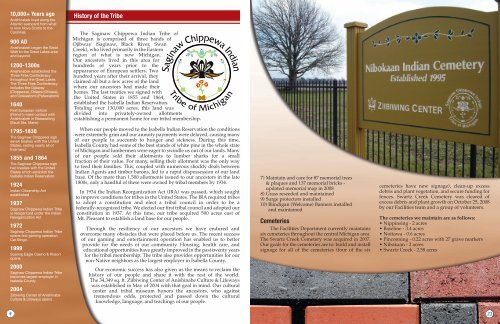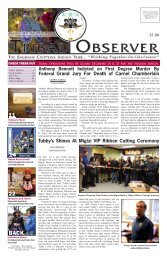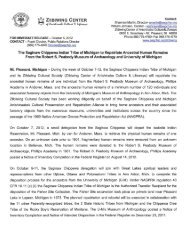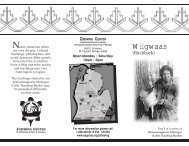Ziibiwing Center - Saginaw Chippewa Indian Tribe of Michigan
Ziibiwing Center - Saginaw Chippewa Indian Tribe of Michigan
Ziibiwing Center - Saginaw Chippewa Indian Tribe of Michigan
- No tags were found...
Create successful ePaper yourself
Turn your PDF publications into a flip-book with our unique Google optimized e-Paper software.
10,000+ Years agoAnishinabek lived along theAtlantic seaboard from whatis now Nova Scotia to theCarolinas900 ADAnishinabek began the GreatWalk to the Great Lakes areaand beyond1200-1300sAnishinabek established theThree Fires Confederacythroughout the Great Lakes.The Three Fires Confederacyincludes the Ojibway(<strong>Chippewa</strong>), Odawa (Ottawa),and Odawatomi (Potawatomi)1640First European visitors(French) make contact withAnishinabek in Baawaating(Sault Ste. Marie)1795-1838The <strong>Saginaw</strong> <strong>Chippewa</strong> signseven treaties with the UnitedStates, ceding nearly all <strong>of</strong>their land1855 and 1864The <strong>Saginaw</strong> <strong>Chippewa</strong> signtwo treaties with the UnitedStates which establish theIsabella <strong>Indian</strong> Reservation1924<strong>Indian</strong> Citizenship Actestablished1937<strong>Saginaw</strong> <strong>Chippewa</strong> <strong>Indian</strong> <strong>Tribe</strong>is reorganized under the <strong>Indian</strong>Reorganization Act1972<strong>Saginaw</strong> <strong>Chippewa</strong> <strong>Indian</strong> <strong>Tribe</strong>opens first gaming operation,Car Bingo1999Soaring Eagle Casino & Resortopens2000<strong>Saginaw</strong> <strong>Chippewa</strong> <strong>Indian</strong> <strong>Tribe</strong>becomes largest employer inIsabella County2004<strong>Ziibiwing</strong> <strong>Center</strong> <strong>of</strong> AnishinabeCulture & Lifeways opensHistory <strong>of</strong> the <strong>Tribe</strong>The <strong>Saginaw</strong> <strong>Chippewa</strong> <strong>Indian</strong> <strong>Tribe</strong> <strong>of</strong><strong>Michigan</strong> is comprised <strong>of</strong> three bands <strong>of</strong>Ojibway (<strong>Saginaw</strong>, Black River, SwanCreek), who lived primarily in the Easternregion <strong>of</strong> what is now <strong>Michigan</strong>.Our ancestors lived in this area forhundreds <strong>of</strong> years prior to theappearance <strong>of</strong> European settlers. Twohundred years after their arrival, theyclaimed all but a few acres <strong>of</strong> the landwhere our ancestors had made theirhomes. The last treaties we signed withthe United States in 1855 and 1864,established the Isabella <strong>Indian</strong> Reservation.Totaling over 130,000 acres, this land wasdivided into privately-owned allotmentsestablishing a permanent home for our tribal membership.When our people moved to the Isabella <strong>Indian</strong> Reservation the conditionswere extremely grim and our annuity payments were delayed, causing many<strong>of</strong> our people to succumb to hunger and sickness. During this time,Isabella County had some <strong>of</strong> the best stands <strong>of</strong> white pine in the whole state<strong>of</strong> <strong>Michigan</strong> and lumbermen were eager to swindle us out <strong>of</strong> our lands. Many<strong>of</strong> our people sold their allotments to lumber sharks for a smallfraction <strong>of</strong> their value. For many, selling their allotment was the only wayto feed their families. This, coupled with numerous shoddy deals between<strong>Indian</strong> Agents and timber barons, led to a rapid dispossession <strong>of</strong> our landbase. Of the more than 1,500 allotments issued to our ancestors in the late1800s, only a handful <strong>of</strong> these were owned by tribal members by 1934.In 1934 the <strong>Indian</strong> Reorganization Act (IRA) was passed, which soughtto improve conditions for tribes in the United States. The IRA required tribesto adopt a constitution and elect a tribal council in order to be afederally-recognized tribe. We elected our first tribal council and adopted ourconstitution in 1937. At this time, our tribe acquired 500 acres east <strong>of</strong>Mt. Pleasant to establish a land base for our people.Through the resiliency <strong>of</strong> our ancestors we have endured andovercome many obstacles that were placed before us. The recent success<strong>of</strong> our gaming and entertainment operation has enabled us to betterprovide for the needs <strong>of</strong> our community. Housing, health care, andeducational opportunities have greatly improved in the past twenty yearsfor the tribal membership. The tribe also provides opportunities for ournon-Native neighbors as the largest employer in Isabella County.Our economic success has also given us the means to reclaim thehistory <strong>of</strong> our people and share it with the rest <strong>of</strong> the world.The 34,349 sq. ft. <strong>Ziibiwing</strong> <strong>Center</strong> <strong>of</strong> Anishinabe Culture & Lifewayswas established in May <strong>of</strong> 2004 with that goal in mind. Our culturalcenter and tribal museum honors the ancestors, who againsttremendous odds, protected and passed down the culturalknowledge, language, and teachings <strong>of</strong> our people.7) Maintain and care for 87 memorial trees& plaques and 137 memorial bricks -updated memorial map in 20088) Grass reseeded and maintained9) Surge protectors installed10) Biindigan (Welcome) Banners installedand maintainedCemeteriesThe Facilities Department currently maintainssix cemeteries throughout the central <strong>Michigan</strong> area.The Swartz Creek Cemetery was acquired in 2007.Our goals for the cemeteries are to: build and installsignage for all <strong>of</strong> the cemeteries (four <strong>of</strong> the sixcemeteries have new signage), clean-up excessdebris and plant vegetation, and secure funding forfences. Swartz Creek Cemetery was cleared <strong>of</strong>excess debris and plant growth on October 25, 2008by our Facilities team and a group <strong>of</strong> volunteers.The cemeteries we maintain are as follows:• Nippinsing - 2 acres• Baseline - 3.4 acres• Nottawa - 0.6 acres• Pinconning - 0.22 acres with 27 grave markers• Nibokaan - 2 acres• Swartz Creek - 2.58 acres4 21
















